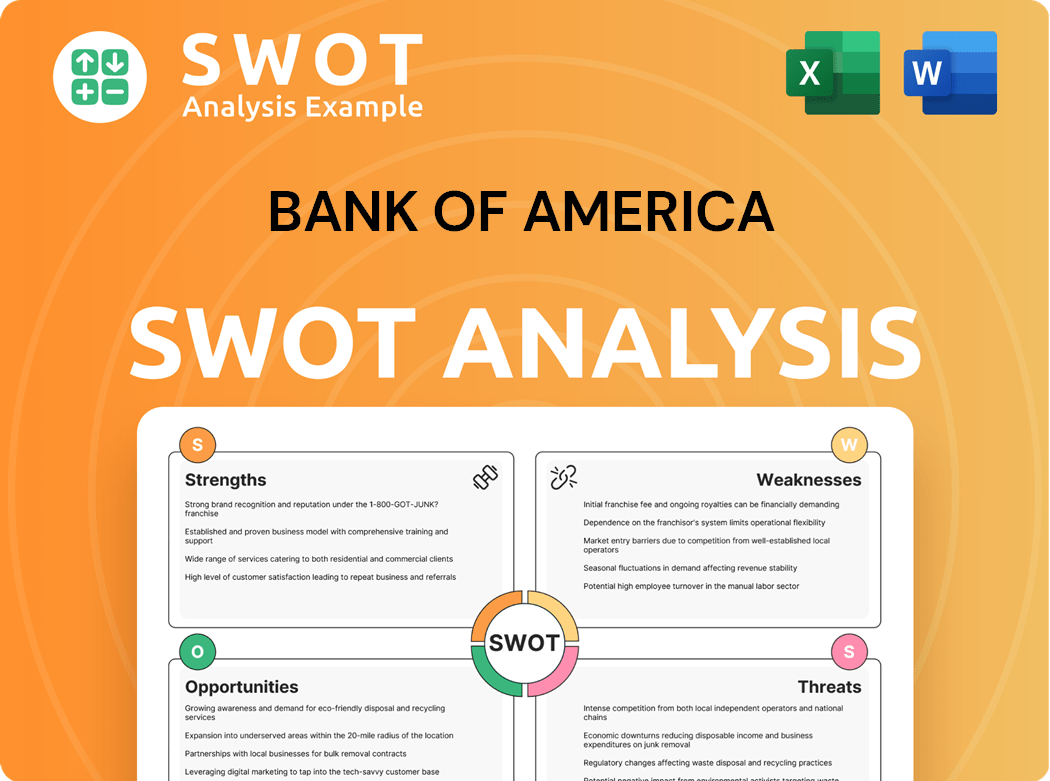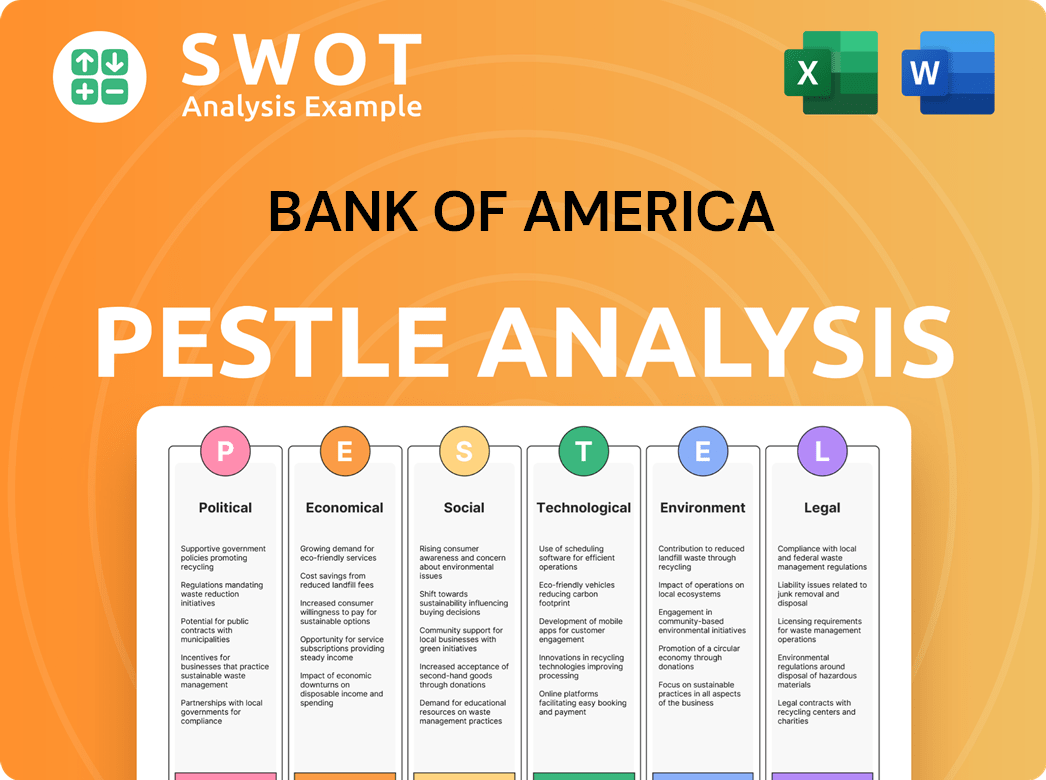Bank of America Bundle
Who Really Controls Bank of America?
Unraveling the Bank of America SWOT Analysis is just the beginning; understanding its ownership is key to grasping its future. The financial world's biggest players often have complex ownership structures, and Bank of America is no exception. Discover the intricate details of who owns Bank of America and how it shapes its strategic decisions.

The question of "Who owns Bank of America?" is vital for any investor or market watcher. Knowing the Bank of America owner and the distribution of its shares provides insights into the company's stability and future direction. This analysis will explore the Bank of America ownership structure, including its shareholders, institutional investors, and the influence of its board of directors, giving you a clear picture of who controls this financial giant. We will also examine the Bank of America stock and its implications for investors, looking at the ownership percentage and shareholding distribution.
Who Founded Bank of America?
The genesis of Bank of America, a financial behemoth, can be traced back to its inception in 1904 as the Bank of Italy. The visionary behind this endeavor was Amadeo Pietro Giannini, an Italian-American immigrant who established the bank with the intention of serving the financial needs of the underserved, particularly immigrants and the working class.
Giannini's pioneering spirit and community-focused approach set the stage for what would become one of the largest financial institutions in the United States. While specific details of the initial ownership structure are scarce, Giannini's personal investment and the support he garnered from local merchants and community members were crucial in establishing the bank's initial capital base.
Early backing for the Bank of Italy came primarily from Italian-American business owners and community members who shared Giannini's vision. These early investors were driven by trust and a shared commitment to the community, rather than a complex shareholding structure. The focus was on growth and expansion to serve the target clientele, with Giannini's leadership and commitment central to the bank's mission.
Amadeo Pietro Giannini founded the Bank of Italy to serve the financial needs of immigrants and the working class.
The initial capital came from Giannini's personal investment and support from local merchants.
Early investors were primarily Italian-American business owners who shared Giannini's community-centric vision.
The early ownership structure was focused on growth and serving the target clientele.
Giannini's leadership and commitment were central to the bank's mission and control.
There were no widely publicized initial ownership disputes or buyouts in the early days.
Understanding the Marketing Strategy of Bank of America can offer further insights into its evolution. The current Bank of America ownership structure is complex, with institutional investors holding a significant portion of the shares. As of the latest reports, institutional investors collectively own over 70% of the outstanding shares, indicating a strong influence from large financial entities. The largest shareholders include firms like The Vanguard Group and BlackRock, each holding substantial percentages of the company's stock. Individual investors and employees own the remaining shares. The ownership structure has evolved significantly since its inception, reflecting the growth and transformation of the bank over the years.
- Institutional investors hold a majority stake in Bank of America.
- Key institutional shareholders include The Vanguard Group and BlackRock.
- The ownership structure has changed significantly since the early days.
- The current structure reflects the bank's growth and market position.
Bank of America SWOT Analysis
- Complete SWOT Breakdown
- Fully Customizable
- Editable in Excel & Word
- Professional Formatting
- Investor-Ready Format

How Has Bank of America’s Ownership Changed Over Time?
The evolution of Bank of America's ownership reflects its growth from a regional bank to a global financial institution. Initially, the company's ownership was concentrated among early investors and founders. However, the decision to go public broadened the shareholder base, allowing for greater capital access and market visibility. A significant turning point was the 1998 merger with NationsBank, which reshaped the ownership structure and significantly increased the company's market capitalization, creating the modern Bank of America.
This merger consolidated two major financial entities, leading to a redistribution of shares among the combined entity's shareholders. This strategic move not only expanded the company's operational capabilities but also altered the composition of its ownership, setting the stage for its future as a publicly traded entity with a diverse shareholder base. Understanding these pivotal moments is crucial for grasping the dynamics of who owns Bank of America and how its ownership has evolved over time.
| Event | Impact on Ownership | Year |
|---|---|---|
| Initial Public Offering | Broadened shareholder base | Early in its History |
| Merger with NationsBank | Redistribution of shares, increased market capitalization | 1998 |
| Acquisition of Merrill Lynch | Further diversification of assets and shareholder base | 2008 |
As of early 2025, the ownership of Bank of America is primarily held by institutional investors. These include major asset management firms, mutual funds, and index funds. For example, Berkshire Hathaway Inc. has historically been a significant shareholder, holding a substantial number of shares. Other major institutional investors typically include Vanguard Group Inc., BlackRock Inc., and State Street Corp. These firms collectively hold a significant percentage of Bank of America's outstanding shares, often ranging from 60% to 80% of the total. Individual insider ownership, including executives and the board of directors, represents a much smaller percentage. This structure is typical for large publicly traded companies, where institutional investors play a crucial role in influencing company strategy and governance. To learn more about the company's origins, you can read Brief History of Bank of America.
Bank of America's ownership is largely institutional, with major firms holding significant stakes.
- Institutional investors, such as Berkshire Hathaway, Vanguard, and BlackRock, are key shareholders.
- The merger with NationsBank in 1998 was a pivotal event in reshaping the ownership structure.
- Understanding the ownership structure is crucial for investors and stakeholders.
- The influence of institutional investors impacts corporate governance and strategy.
Bank of America PESTLE Analysis
- Covers All 6 PESTLE Categories
- No Research Needed – Save Hours of Work
- Built by Experts, Trusted by Consultants
- Instant Download, Ready to Use
- 100% Editable, Fully Customizable

Who Sits on Bank of America’s Board?
As of early 2025, the Board of Directors of Bank of America comprises a blend of independent directors and executive management. This structure is designed to ensure robust corporate governance. The board's composition typically includes individuals with expertise in finance, technology, and risk management, among other areas. The majority of board members are independent, adhering to standard practices for large public companies to maintain objective oversight. This structure helps in representing the interests of the diverse shareholder base effectively.
The board's decisions are primarily guided by the collective interests of its shareholder base and its fiduciary duty to the company's long-term health and performance. Institutional investors do not typically seek direct board representation unless they are activist investors. Instead, their influence is exerted through proxy voting. The voting structure generally follows a one-share-one-vote principle, ensuring each common share entitles its holder to one vote on shareholder matters. The company does not have dual-class shares or other mechanisms granting outsized control to specific entities.
| Director | Position | Key Experience |
|---|---|---|
| Brian Moynihan | Chairman of the Board and CEO | Extensive experience in financial services, including leadership roles at the company. |
| Thomas J. Baltimore, Jr. | Lead Independent Director | Significant experience in real estate and investment management. |
| Linda P. Bammann | Independent Director | Experience in the technology sector and corporate governance. |
In recent years, Bank of America, like many large corporations, has faced scrutiny regarding executive compensation and environmental, social, and governance (ESG) initiatives. These factors can sometimes lead to activist investor campaigns or proxy battles. However, there have been no major, highly publicized proxy battles or governance controversies that have fundamentally reshaped decision-making within the company in the immediate past (2024-2025 timeframe). Understanding the Target Market of Bank of America provides further insights into the company's strategic direction and stakeholder engagement.
Bank of America's ownership is primarily distributed among institutional investors and the public. The voting structure is one-share-one-vote. The board of directors is composed of independent directors and executive management.
- Institutional investors hold a significant portion of Bank of America stock.
- The company's governance structure aims for objective oversight.
- The board's decisions are influenced by shareholder interests.
- No single entity has outsized control through special share classes.
Bank of America Business Model Canvas
- Complete 9-Block Business Model Canvas
- Effortlessly Communicate Your Business Strategy
- Investor-Ready BMC Format
- 100% Editable and Customizable
- Clear and Structured Layout

What Recent Changes Have Shaped Bank of America’s Ownership Landscape?
Over the past few years (2022-2025), the ownership of Bank of America has remained relatively stable, mirroring broader trends in the financial sector. A key aspect of this stability has been the bank’s consistent share buyback programs. These programs aim to return value to shareholders and optimize the capital structure. For example, in early 2025, substantial share repurchases continued, which can increase earnings per share, thereby consolidating ownership among existing shareholders. This strategy has been a consistent feature, reflecting a focus on shareholder value.
There have been no significant changes in the ownership structure due to major secondary offerings or large-scale mergers. While the company does engage in strategic acquisitions, these typically do not fundamentally alter its ownership. Leadership transitions, such as executive retirements, are part of normal succession planning and haven't triggered major shifts in ownership control. The trends of increasing institutional ownership, especially by passive index funds, continue to be evident. This generally leads to a more stable ownership structure for the bank. You can also read about the Growth Strategy of Bank of America.
Industry-wide trends, such as the rise of passive index funds, are evident in Bank of America's shareholder base, contributing to a more stable ownership structure. The company's focus remains on capital return strategies and financial performance, rather than major ownership changes. The ownership dynamics of Bank of America haven't been significantly impacted by activist investors in recent years. The top shareholders include large institutional investors that hold a significant portion of the outstanding shares.
Institutional investors, including passive index funds, hold a substantial portion of Bank of America's stock. This ownership structure contributes to the overall stability of the bank's shareholder base. The presence of long-term holders, such as these funds, typically reduces volatility and supports the company's strategic focus.
Bank of America has consistently executed share repurchase programs. These buybacks are a key part of the bank’s capital allocation strategy. They reduce the number of outstanding shares, potentially increasing earnings per share, and returning value to shareholders.
The ownership structure of Bank of America has shown considerable stability in recent years. There haven't been major shifts due to large-scale mergers or significant secondary offerings. This stability provides a solid foundation for the bank's long-term strategic initiatives and operational performance.
Activist investor campaigns have not significantly influenced Bank of America's ownership dynamics. The bank's strategic direction and board composition have remained largely unaffected. This indicates a strong level of confidence in the current management and strategic plan.
Bank of America Porter's Five Forces Analysis
- Covers All 5 Competitive Forces in Detail
- Structured for Consultants, Students, and Founders
- 100% Editable in Microsoft Word & Excel
- Instant Digital Download – Use Immediately
- Compatible with Mac & PC – Fully Unlocked

Related Blogs
- What are Mission Vision & Core Values of Bank of America Company?
- What is Competitive Landscape of Bank of America Company?
- What is Growth Strategy and Future Prospects of Bank of America Company?
- How Does Bank of America Company Work?
- What is Sales and Marketing Strategy of Bank of America Company?
- What is Brief History of Bank of America Company?
- What is Customer Demographics and Target Market of Bank of America Company?
Disclaimer
All information, articles, and product details provided on this website are for general informational and educational purposes only. We do not claim any ownership over, nor do we intend to infringe upon, any trademarks, copyrights, logos, brand names, or other intellectual property mentioned or depicted on this site. Such intellectual property remains the property of its respective owners, and any references here are made solely for identification or informational purposes, without implying any affiliation, endorsement, or partnership.
We make no representations or warranties, express or implied, regarding the accuracy, completeness, or suitability of any content or products presented. Nothing on this website should be construed as legal, tax, investment, financial, medical, or other professional advice. In addition, no part of this site—including articles or product references—constitutes a solicitation, recommendation, endorsement, advertisement, or offer to buy or sell any securities, franchises, or other financial instruments, particularly in jurisdictions where such activity would be unlawful.
All content is of a general nature and may not address the specific circumstances of any individual or entity. It is not a substitute for professional advice or services. Any actions you take based on the information provided here are strictly at your own risk. You accept full responsibility for any decisions or outcomes arising from your use of this website and agree to release us from any liability in connection with your use of, or reliance upon, the content or products found herein.